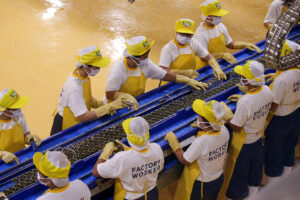By Lourdes O. Pilar, Researcher
MANUFACTURING OUTPUT GROWTH eased in May as production of computer, chemical, and metal products contracted, the Philippine Statistics Authority (PSA) reported on Tuesday.
Preliminary results of the PSA’s latest Monthly Integrated Survey of Selected Industries showed factory output, as measured by the volume of production index (VoPI), grew by 3.2% year on year in May.
However, May output growth slowed from the revised 6.3% in April and 6.1% logged in the same month a year ago.
It was also the slowest pace of growth in two months since the revised 5.5% decline in March.
On a month-on-month basis, the manufacturing sector’s VoPI rose by 1.5% in May from the 1.1% decline in April. Stripping out seasonality factors, factory output that month dipped by 0.03%.
For the January-to-May period, factory output growth averaged 0.9%, significantly slowing from 6.3% a year ago.
To compare, S&P Global Philippines Manufacturing Purchasing Managers’ Index stood at 54.1 in May, slightly down from 54.3 in April. A reading above 50 marks improvement for the manufacturing sector while anything below indicates deterioration.
Ser Percival K. Peña-Reyes, director of the Ateneo de Manila University Center for Economic Research and Development, said in a phone interview that manufacturing growth in May eased due to sluggish demand.
“The lethargic demand is still contending with inflation. Although it is decelerating, people can still feel it,” he said.
On the supply side, Mr. Peña-Reyes said manufacturers have also had to deal with rising costs, delays at Customs and traffic.
“All of these contributing to the easing of manufacturing. If you are to imagine the buyer’s supply and demand curves, both are shifting to the left, output unequivocally decreases, but the effect on price is ambiguous,” he added.
John Paolo R. Rivera, senior research fellow at the Philippine Institute for Development Studies, said high inflation and the peso depreciation also contributed to the easing manufacturing output.
“These contributed to making the raw materials and work-in-progress costlier, especially those that are being imported. Currency depreciation makes imported inputs to manufacturing more expensive,” Mr. Rivera said in an e-mail.
In mid-May, the peso sank to the P58-per-dollar level for the first time in 18 months or since November 2022. The peso closed at P58.52 against the dollar as of end-May, depreciating by P0.94 from its P57.58 finish as of end-April.
Inflation accelerated to a six-month high in May, driven by the faster rise in utility and transport costs. The consumer price index picked up to 3.9% year on year in May from 3.8% in April but slowed from 6.1% in the same month last year.
The PSA said the contraction in three leading industry divisions weighed on overall output, namely fabricated products, except machinery and equipment (-13.4% in May from 29.9% in April); chemical and chemical products (-17.7% from 16.6%); and computer, electronic, and optical products (-0.3% from 5.2%).
Fifteen industry divisions also saw contractions in May.
On the other hand, the manufacture of coke and refined petroleum products posted the fastest growth at 53.6% from 18.7% in April.
Average capacity utilization — the extent to which industry resources are used in producing goods — averaged 75.5% in May. This is slightly higher than 75.3% in the previous month and 73.5% in May 2023.
All industry divisions recorded an average capacity utilization rate of at least 60% for the month. The manufacture of paper and paper products recorded the slowest growth at 65%.
“Inflation tends to dampen spending, but if inflation improves, manufacturing could grow better in June,” said Mr. Peña-Reyes.
